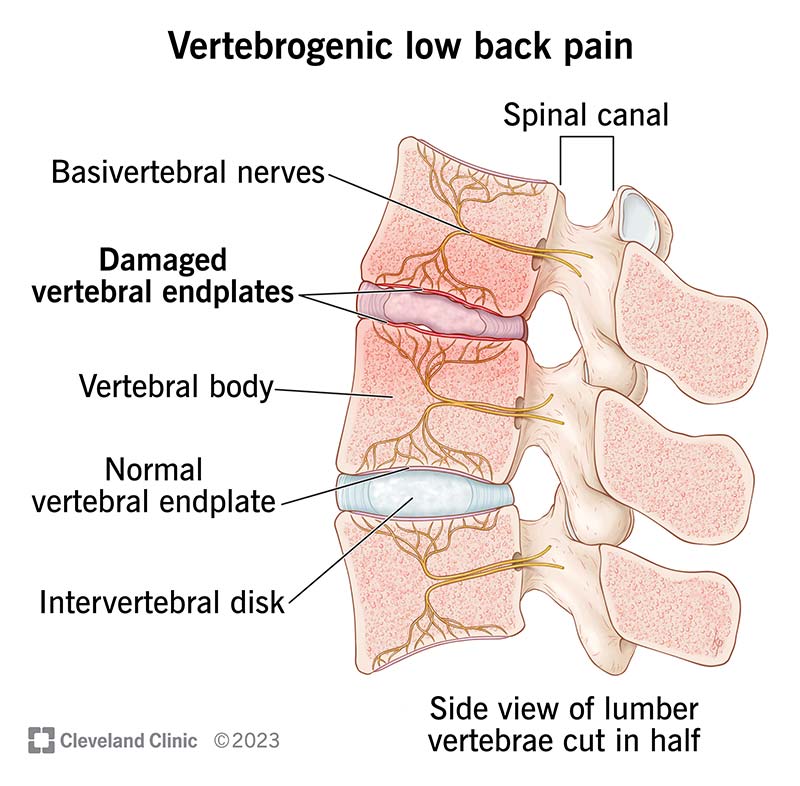Vertebrogenic low back pain is a specific type of back pain that develops when the vertebral endplates in your spine become damaged. The condition is often a result of wear and tear over time. Treatments include medications, physical therapy and basivertebral nerve ablation.
Advertisement
Cleveland Clinic is a non-profit academic medical center. Advertising on our site helps support our mission. We do not endorse non-Cleveland Clinic products or services. Policy

Vertebrogenic low back pain happens when the vertebral endplates in your spine become damaged. Your endplates are protective layers between your vertebral bones and the disks that cushion them.
Advertisement
Cleveland Clinic is a non-profit academic medical center. Advertising on our site helps support our mission. We do not endorse non-Cleveland Clinic products or services. Policy
Vertebrogenic pain is distinct from other types of chronic low back pain. While injuries or arthritis cause other types of back pain, damaged endplates are the culprit of vertebrogenic pain.
In the past, healthcare providers attributed most cases of chronic low back pain to degenerative disk disease or arthritis. However, researchers later discovered nerves inside your vertebrae that can cause pain when they’re compressed. This new information shed light on other potential causes of back pain, suggesting that degenerative disk disease or arthritis may not always be to blame.
Over 30 million people in the United States have some type of chronic low back pain. But it’s hard to say how many of those cases are due to vertebrogenic pain. In fact, healthcare providers can only find a direct cause for chronic low back pain in about 20% of cases. Healthcare providers describe the other 80% as non-specific.
People with vertebrogenic pain often describe it as a deep, burning or aching pain in the middle of their lower back. Some may develop referred pain (when you feel pain in another area instead of where it originated).
Pain often gets worse when you:
Advertisement
Because of similar symptoms and presentation, providers may misdiagnose vertebrogenic pain as degenerative disk disease. But to further complicate things, some people can have both. If you have a degenerated disk in addition to damaged endplates in your lower back, you might notice additional symptoms like:
These symptoms occur because disks can shift (or herniate) and have the potential to impinge (press) on nearby nerves (although they don’t always).
Damaged endplates in your vertebra cause vertebrogenic low back pain. And lots of things can contribute to the breakdown of your endplates, including:
First, a healthcare provider will do a physical examination. They may feel along your spine and ask you to move in specific ways to see if certain positions cause more pain. They’ll also ask about your symptoms and whether chronic back pain runs in your family.
If your provider thinks you have an issue with your spine, they’ll likely recommend imaging tests. It’s common to start with a spine X-ray to evaluate back pain. Based on your evaluation, your provider may request additional imaging like a CT (computed tomography) scan or MRI (magnetic resonance imaging). These tests may help your provider look for bone marrow inflammation and other signs of changes to your vertebral endplates.
Providers use a few different approaches to treat vertebrogenic pain, including:
People with vertebrogenic low back pain have more treatment options today compared to a few decades ago. Still, a proper diagnosis can take time — and you might have to try a couple of different treatments before you find a solution that works for you.
Statistically, the most effective treatment for vertebrogenic pain is basivertebral nerve ablation. But to qualify for coverage, you’ll probably need to try more conservative treatments first. Your healthcare provider can help you file insurance and recommend ways to reduce pain in the meantime.
Advertisement
You can’t always prevent vertebrogenic pain because it’s often a product of natural wear and tear. But there are things you can do to reduce your risk:
You should schedule an appointment with a healthcare provider if you develop:
Back pain can have a significant negative impact on your quality of life. And if you have chronic low back pain that lingers or doesn’t improve with conventional treatments, it can feel hopeless and frustrating. If you have a deep, burning achiness in the middle of your lower back, it could be vertebrogenic low back pain. Talk to your healthcare provider about your symptoms so they can help you find appropriate treatment.
Advertisement
Low back pain can be a constant interruption in your daily life. Cleveland Clinic’s experts can help craft a treatment plan to help you find relief.

Last reviewed on 01/08/2024.
Learn more about the Health Library and our editorial process.